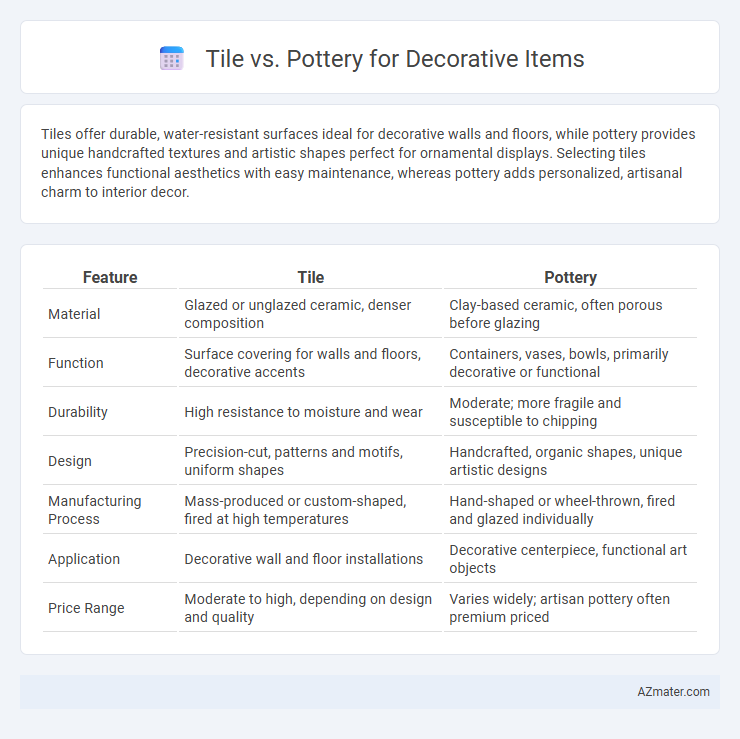Tiles offer durable, water-resistant surfaces ideal for decorative walls and floors, while pottery provides unique handcrafted textures and artistic shapes perfect for ornamental displays. Selecting tiles enhances functional aesthetics with easy maintenance, whereas pottery adds personalized, artisanal charm to interior decor.
Table of Comparison
| Feature | Tile | Pottery |
|---|---|---|
| Material | Glazed or unglazed ceramic, denser composition | Clay-based ceramic, often porous before glazing |
| Function | Surface covering for walls and floors, decorative accents | Containers, vases, bowls, primarily decorative or functional |
| Durability | High resistance to moisture and wear | Moderate; more fragile and susceptible to chipping |
| Design | Precision-cut, patterns and motifs, uniform shapes | Handcrafted, organic shapes, unique artistic designs |
| Manufacturing Process | Mass-produced or custom-shaped, fired at high temperatures | Hand-shaped or wheel-thrown, fired and glazed individually |
| Application | Decorative wall and floor installations | Decorative centerpiece, functional art objects |
| Price Range | Moderate to high, depending on design and quality | Varies widely; artisan pottery often premium priced |
Introduction: Comparing Tile and Pottery for Decorative Items
Tile and pottery each offer unique aesthetic and functional qualities as decorative items, with tiles providing durable, geometric designs ideal for wall and floor embellishments, while pottery features handcrafted, organic forms that bring warmth and artistic expression to any space. Tiles often incorporate intricate patterns and glossy finishes that enhance modern and traditional interiors, whereas pottery showcases textures and glazes that reflect cultural heritage and craftsmanship. Selecting between tile and pottery depends on desired visual impact, durability needs, and the decorative style intended for the environment.
Material Composition: Tile vs Pottery
Tile is typically made from clay or ceramic materials, often mixed with additives like quartz and feldspar to enhance durability and water resistance, making it ideal for both functional and decorative applications. Pottery primarily consists of natural clay fired at various temperatures, resulting in a porous and less water-resistant material compared to tile, which is usually glazed to improve its aesthetic and protective qualities. The composition differences influence each item's longevity, texture, and suitability for indoor versus outdoor decorative use.
Design Versatility and Aesthetic Appeal
Tile offers exceptional design versatility with a wide range of colors, patterns, and textures suitable for intricate mosaics and modern geometric designs, making it ideal for contemporary and traditional decor styles. Pottery, characterized by its handcrafted quality and organic forms, provides unique aesthetic appeal through natural glazes and artisanal craftsmanship, creating warm and rustic decorative accents. Both materials enhance spaces differently: tile excels in creating bold, customizable surfaces, while pottery delivers tactile, one-of-a-kind artistic expression.
Durability and Longevity
Tiles offer superior durability for decorative items due to their resistance to moisture, scratches, and temperature fluctuations, making them ideal for both indoor and outdoor use. Pottery, while aesthetically appealing, is more susceptible to chipping and cracking over time, especially when exposed to heavy impact or changing environmental conditions. High-quality ceramic tiles can last several decades with minimal maintenance, whereas pottery often requires careful handling to preserve its longevity.
Craftsmanship and Manufacturing Techniques
Tile craftsmanship involves precision cutting, glazing, and firing techniques that create durable, intricate designs ideal for both aesthetic and functional purposes. Pottery making emphasizes hand-building or wheel-throwing methods, with artisans shaping clay before glazing and kiln firing to achieve unique textures and organic forms. Manufacturing tiles often uses mechanized processes to ensure uniformity, while pottery relies on artisanal skills that highlight individuality and handcrafted detail.
Customization Options
Tiles offer extensive customization options, including a wide range of colors, patterns, shapes, and sizes that can be tailored to fit various design themes and architectural requirements. Pottery customization focuses on unique hand-crafted techniques, allowing for personalized textures, glazing finishes, and artistic motifs, often resulting in one-of-a-kind decorative pieces. Both materials provide versatility, but tiles excel in modular and scalable designs while pottery emphasizes artisanal individuality.
Maintenance and Care Requirements
Tiles offer low maintenance with their smooth, non-porous surfaces that resist stains and are easy to clean using mild detergent and water. Pottery, especially unglazed or porous varieties, requires more careful care to avoid chipping and moisture absorption, often needing gentle handling and occasional sealing. Both materials benefit from regular dusting, but pottery demands more cautious storage and placement to maintain its decorative appeal.
Cost Comparison
Tile generally offers a more cost-effective option for decorative items compared to pottery, with prices ranging from $5 to $20 per square foot, depending on material and design complexity. Pottery, especially handcrafted pieces, tends to be pricier, often falling between $30 and $100 or more per item due to labor-intensive processes and unique artistry. Choosing tile can reduce expenses for large-scale decoration projects, while pottery suits smaller, distinctive decor where higher costs are justified by aesthetic value.
Eco-Friendliness and Sustainability
Tiles made from natural materials like clay and recycled content offer high durability and low environmental impact, making them a sustainable choice for decorative items. Pottery, often handcrafted from locally sourced clay and fired with minimal waste, supports eco-friendly artisanal practices and biodegradable properties. Both options contribute to reducing carbon footprint, but tiles frequently provide longer lifespan and lower maintenance requirements, enhancing overall sustainability in home decor.
Choosing the Right Decorative Item: Tile or Pottery?
When choosing between tile and pottery for decorative items, consider durability, design complexity, and placement environment. Tiles offer high durability and easy maintenance, ideal for wall installations and areas prone to moisture, while pottery provides unique, handcrafted aesthetics with varied textures and shapes, suitable for display on shelves or tables. Assess the desired visual impact and functional requirements to select the most fitting decorative element for your space.

Infographic: Tile vs Pottery for Decorative Item
 azmater.com
azmater.com